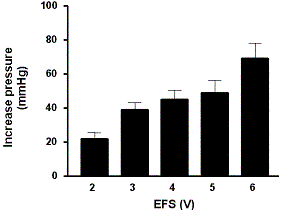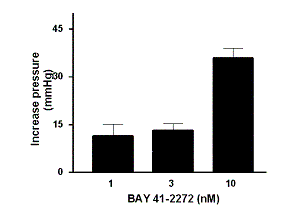| pA2 online © Copyright 2004 The British Pharmacological Society |
043P
GKT, University of London Winter Meeting December 2003 |
|
BAY 41-2272
relaxes rat corpus cavernosum in vitro and in vivo |
|
BAY 41-2272 was recently identified as a potent sGC stimulator in a nitric oxide (NO)-independent manner. This study aimed to investigate the effects of BAY 41-2272 in the rat corpus cavernosum(RCC) in vitro and in vivo.Strips of RCC were mounted in organ baths and connected to isometric transducers to record BAY 41-2272-evoked relaxations. In addition, intracavernous pressure (ICP) was recorded in anesthetized rats both in response to stimulation of the cavernous nerve and to BAY 41-2272 given intracavernously.
BAY 41-2272 (0.01-10 µM) relaxed the RCC in a concentration-dependent manner (n=16), with a pEC50 value of 6.56 ± 0.12. The sGC inhibitor ODQ (10 µM) caused a rightward shift (8.2-fold) in the concentration-response curve to BAY 41-2272. Similarly, the NO synthesis inhibitor L-NAME (100 µM) shifted the concentration-response curve to BAY 41-2272 to the right (2.0-fold). On the other hand, the phosphodiesterase type 5 inhibitor tadalafil (0.1 µM) caused a leftward shift in the concentration-response curve to BAY 41-2272 (2.0-fold). Stimulation of the cavernous nerve (2-6 V; 12 Hz) induced voltage-dependent increases in ICP (maximal increase of 69.1 ± 9.1 mmHg). Administration of BAY 41-2272 (1-10 nmol) also significantly increased ICP in a dose-dependent manner (maximal increase of 35.9 ± 3.3 mmHg). The results indicate that BAY 41-2272 induces erectile responses in RCC, in vitro and in vivo. The finding that L-NAME reduces BAY 41-2272-evoked relaxations suggests that this compound synergizes with endogenous NO to elicit its erectile response.


Figure 1 - Stimulation of the cavernous nerve (2-6 V; 12 Hz) induced voltage-dependent increases in ICP (maximal increase of 69.1 ± 9.1 mmHg - top panel; n=6). Administration of BAY 41-2272 (1-10 nmol) also significantly increased ICP in a dose-dependent manner (maximal increase of 35.9 ± 3.3 mmHg - bottom panel; n=6-8).